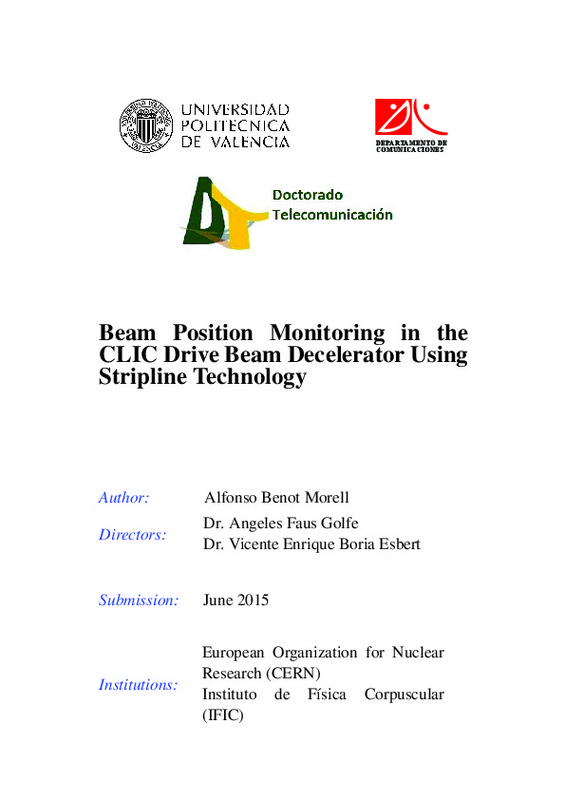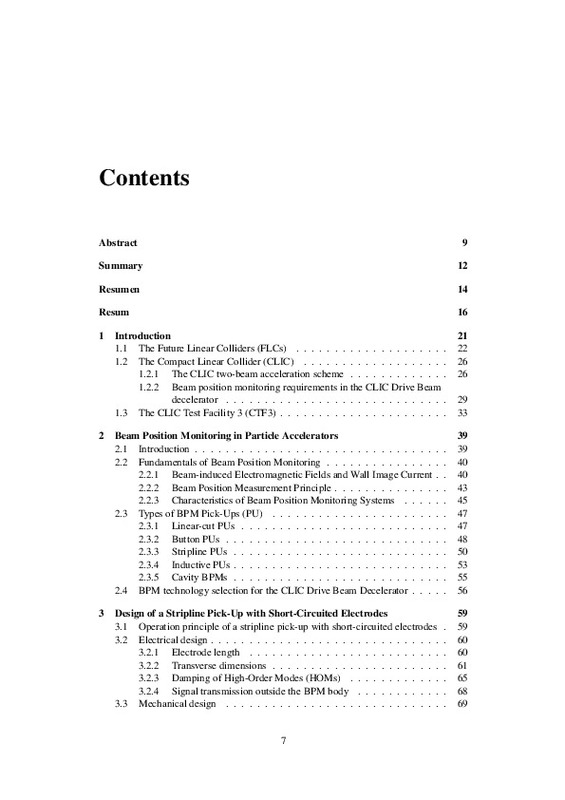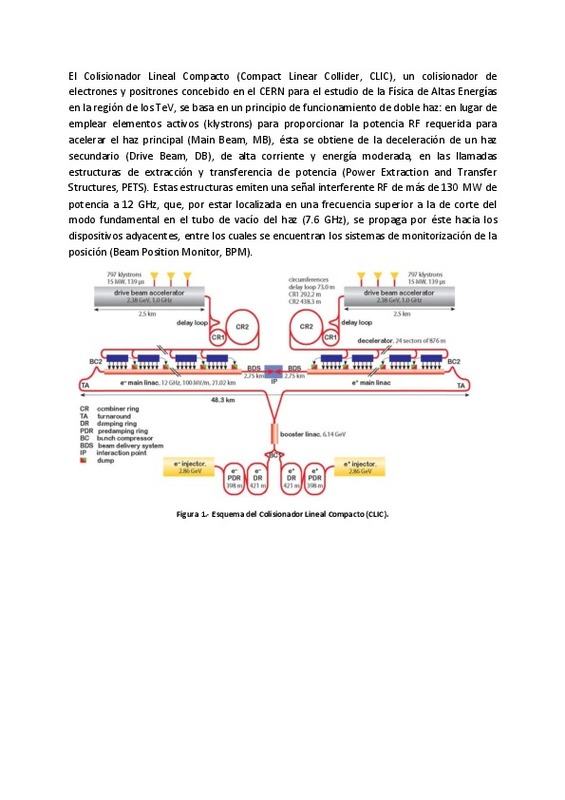- RiuNet repositorio UPV
- :
- Investigación
- :
- Tesis doctorales
- :
- Ver ítem
JavaScript is disabled for your browser. Some features of this site may not work without it.
Buscar en RiuNet
Listar
Mi cuenta
Estadísticas
Ayuda RiuNet
Admin. UPV
Beam position monitoring in the clic drive beam decelerator using stripline technology
Mostrar el registro sencillo del ítem
Ficheros en el ítem
| dc.contributor.advisor | Boria Esbert, Vicente Enrique
|
es_ES |
| dc.contributor.advisor | Faus Golfe, Ángeles
|
es_ES |
| dc.contributor.author | Benot Morell, Alfonso
|
es_ES |
| dc.date.accessioned | 2016-05-16T06:32:22Z | |
| dc.date.available | 2016-05-16T06:32:22Z | |
| dc.date.created | 2016-02-22 | es_ES |
| dc.date.issued | 2016-05-16 | es_ES |
| dc.identifier.uri | http://hdl.handle.net/10251/64067 | |
| dc.description.abstract | [EN] The Compact Linear Collider (CLIC) is an electron-positron collider conceived for the study of High-Energy Physics in the TeV center of mass energy region, is based on a two-beam operation principle: instead of using active elements (klystrons), the necessary RF power to accelerate the Main Beam (MB) is obtained from the deceleration of a high-current, moderate energy Drive Beam (DB) in the so-called Power Extraction and Transfer Structures (PETS). These structures emit an RF signal of about 130 MW power at 12 GHz. As this frequency is above the cut-o ff frequency of the fundamental mode for the specified beam pipe dimensions (7.6 GHz), the inference propagates from the PETS to the neighboring devices, including the Beam Position Monitors (BPM). According to the CLIC Conceptual Design Report (CDR), an ef ficient beam position monitoring system for the CLIC DB decelerator needs to meet the following requirements: - It should be as simple and economic as possible, as 41580 units are required, amounting to 75% of all CLIC BPMs. - The signal processing scheme should not be a ffected by the PETS interference. This rules out processing the signals at the beam bunching frequency (12 GHz). - The resulting position signal should detect changes in the beam position whose duration is 10 ns or longer. - The required spatial resolution is 2 um for a 23 mm diameter vacuum pipe. - Wide dynamic range: the electronic acquisition system must be able to process signals with extreme levels, induced by either very high (100 A) or very low (3 A) current beams. This PhD thesis describes the electromagnetic and mechanical design of the first prototype BPM developed for the CLIC Drive Beam and its characterization tests in laboratory and with beam. The first two chapters introduce the CLIC project and review the state-of-the-art beam position monitoring techniques. Chapter 3 presents the design of the BPM. The stripline technology has been selected, as it is the only one among the most commonly used BPM techniques to present a suitable frequency response to filter out the RF interference caused by the PETS. Choosing an appropriate length for the electrodes, it is possible to tune one the periodic notches in the stripline frequency response to 12 GHz. The influence of di erent electromagnetic and geometrical aspects is also studied, such as beam coupling impedance or the ratio between longitudinal and transverse dimensions. The design of the electronic acquisition system is presented in Chapter 4, considering the project requirements in terms of resolution (2 u m), accuracy (20 um) and time resolution (10 ns). Due to the high amount of units required, the number of electronics components has been minimized. As the designed signal processing scheme is based on charge integration, it can be adapted to di erent stripline pick-ups by simply modifying the attenuator settings according to the required output signal levels. The laboratory characterization tests of the prototype stripline BPM, in the low and the high frequency ranges, performed with a thin wire and a coaxial waveguide, respectively, are described in Chapter 5. The measurement results are compared with the theoretical estimation and the electromagnetic field simulations. In addition, the high-frequency test reveals that the first prototype stripline BPM does not provide su cient suppression of the 12 GHz PETS RF interference. An additional study proposed several modifications and guidelines for a second prototype stripline BPM. Finally, Chapter 6 presents the beam tests of the prototype stripline BPM at the CLIC Test Facility 3 (CTF3) in the Test Beam Line (TBL), a scaled version of the CLIC Drive Beam decelerator. Two types of tests were performed: linearity/sensivity and resolution. These results are compared to the ones in the laboratory characterization tests. An upper bound of the resolution is estimated performing a Singular Value Decomposition (SVD) analysis. | en_EN |
| dc.description.abstract | [ES] El Colisionador Lineal Compacto (Compact Linear Collider, CLIC), un colisionador de electrones y positrones concebido en el CERN para el estudio de la Física de Altas Energías en la región de los TeV, se basa en un principio de funcionamiento de doble haz: en lugar de emplear elementos activos (klystrons) para proporcionar la potencia RF requerida para acelerar el haz principal (Main Beam, MB), ésta se obtiene de la deceleración de un haz secundario (Drive Beam, DB), de alta corriente y energía moderada, en las llamadas estructuras de extracción y transferencia de potencia (Power Extraction and Transfer Structures, PETS). Estas estructuras emiten una señal interferente RF de más de 130 MW de potencia a 12 GHz, que, por estar localizada en una frecuencia superior a la de corte del modo fundamental en el tubo de vacío del haz (7.6 GHz), se propaga por éste hacia los dispositivos adyacentes, entre los cuales se encuentran los sistemas de monitorización de la posición (Beam Position Monitor, BPM). De acuerdo con el informe conceptual de diseño de CLIC (Conceptual Design Report, CDR) , un sistema eficiente de monitorización de la posición del haz en el decelerador del haz secundario deberá cumplir los siguientes requisitos: - Debe ser lo más sencillo y económico posible, ya que se precisan 41580 unidades: el 75% de todos los BPMs de CLIC. - El procesado de señal en el sistema de adquisición deberá ser inmune a la interferencia generada en las PETS. Esto excluye la solución habitual de procesar las señales del BPM a la frecuencia de pulsado del haz (12 GHz). - La señal de posición resultante del procesado debe ser capaz de detectar cambios en la posición del haz de duración igual o mayor a 10 ns (resolución temporal). - La resolución espacial requerida es de 2 um para un tubo de vacío de 23 mm de diámetro, con una calibración precisa. - Amplio rango dinámico: el sistema electrónico de adquisición del BPM debe poder resistir los altos valores de señal provocados por los casos de desviación extrema del haz nominal (se contempla una desviación máxima de la mitad del radio del tubo), así como detectar las señales inducidas por las configuraciones de haz con menor carga de todas las previstas, cuyos niveles serán muy débiles. | es_ES |
| dc.description.abstract | [CA] El Col·lisionador Lineal Compacte (Compact Linear Collider, CLIC), un col·lisionador d'electrons i positrons concebut per l'estudi de la Física d'Altes Energies a la regió dels TeV (energía del centre de massa), es basa en un principi de funcionament de doble feix:en lloc de fer servir elements actius (klystrons) per proporcionar la potència RF requerida per accelerar el feix principal (Main Beam, MB), aquesta s'obtè de la desacceleració d'un feix secundari (Drive Beam, DB), d'alt corrent i energia moderada, a les anomenades estructures d'extracció i transferència de potència (Power Extraction and Transfer Structures, PETS). Aquestes estructures emeten una senyal interferent RF de més de 130 MW de potència a 12 GHz, que, pel fet d'estar localitzada a una freqüència superior a la de tall del mode fonamental al tub de buit del feix (7.6 GHz), es propaga a través d'aquest fins els dispositius adjacents, entre els quals trobem els sistemes de monitorització de la posició (Beam Position Monitor, BPM). D'acord amb l'informe conceptual de disseny de CLIC (Conceptual Design Report, CDR), un sistema eficient de monitorització de la posició del feix al desaccelerador del feix secundari haurà de complir els següents requisits: ¿ - Ha de ser el més senzill i econòmic possible, ja que es necessiten 41580 unitats: el 75% de tots els BPMs de CLIC. ¿ - El processat de la senyal al sistema d'adquisició haurà de ser inmune a la interferència generada als PETS. Això exclou la solució habitual de processar les senyals del BPM a la freqüència de pulsacions del feix (12 GHz). ¿- La senyal de posició resultant del processat ha de ser capaç de detectar canvis a la posició del feix de durada igual o més gran que 10 ns (resolució temporal). ¿- La resolució espaial necessària és de 2 um per a un tub de buit de 23 mm de diàmetre. ¿- Ampli rang dinàmic: el sistema electrònic d'adquisició del BPM ha de poder processar senyals amb nivells extrems, induïdes per feixos de molt alt (100 A) i molt baix (3 A) corrent. | ca_ES |
| dc.language | Inglés | es_ES |
| dc.publisher | Universitat Politècnica de València | es_ES |
| dc.rights | Reserva de todos los derechos | es_ES |
| dc.subject | Particle accelerator | es_ES |
| dc.subject | Linear collider | |
| dc.subject | Beam instrumentation | |
| dc.subject | Beam diagnostics | |
| dc.subject | Beam Position Monitor | |
| dc.subject | Stripline pick-up | |
| dc.subject | CLIC | |
| dc.subject | CTF3 | |
| dc.subject | TBL | |
| dc.subject | CERN | |
| dc.subject | IFIC | |
| dc.subject.classification | TEORIA DE LA SEÑAL Y COMUNICACIONES | es_ES |
| dc.title | Beam position monitoring in the clic drive beam decelerator using stripline technology | es_ES |
| dc.type | Tesis doctoral | es_ES |
| dc.identifier.doi | 10.4995/Thesis/10251/64067 | es_ES |
| dc.rights.accessRights | Abierto | es_ES |
| dc.contributor.affiliation | Universitat Politècnica de València. Departamento de Comunicaciones - Departament de Comunicacions | es_ES |
| dc.description.bibliographicCitation | Benot Morell, A. (2016). Beam position monitoring in the clic drive beam decelerator using stripline technology [Tesis doctoral]. Universitat Politècnica de València. https://doi.org/10.4995/Thesis/10251/64067 | es_ES |
| dc.description.accrualMethod | TESIS | es_ES |
| dc.type.version | info:eu-repo/semantics/acceptedVersion | es_ES |
| dc.relation.pasarela | TESIS\9663 | es_ES |
Este ítem aparece en la(s) siguiente(s) colección(ones)
-
Tesis doctorales [5389]










